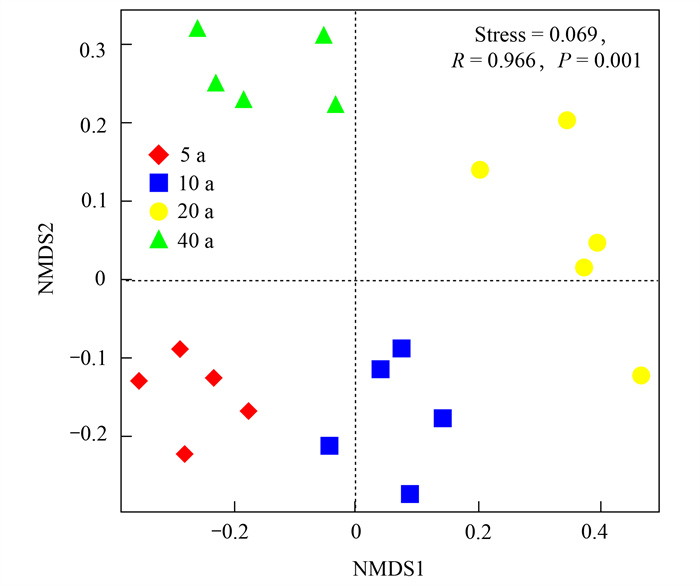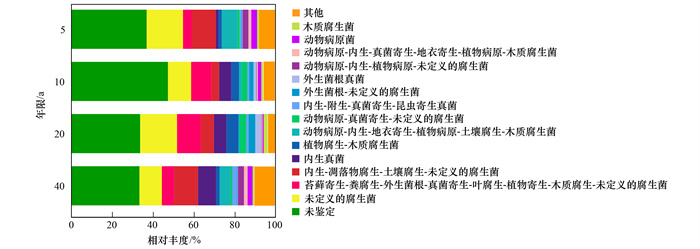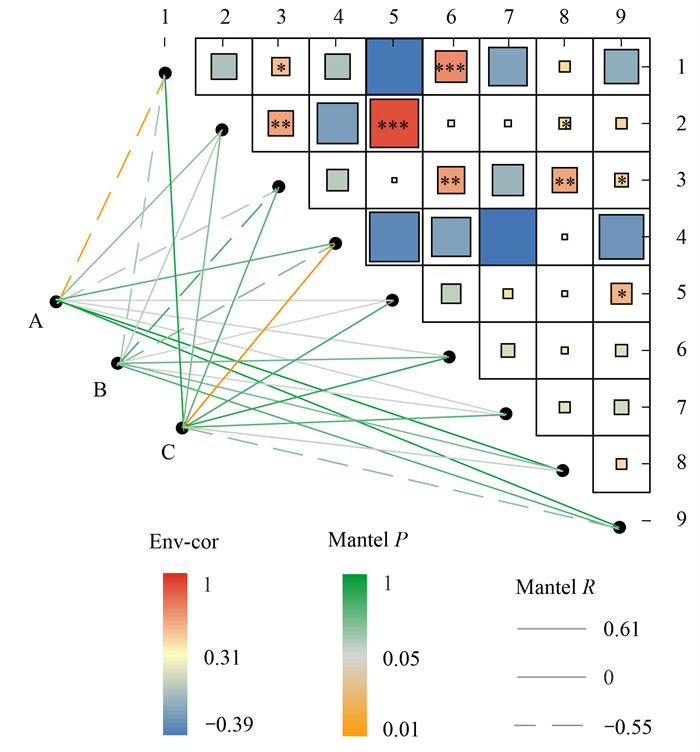2. 西南林业大学湿地学院, 国家高原湿地研究中心, 昆明 650224
2. National Plateau Wetlands Research Center, College of Wetlands, Southwest Forestry University, Kunming 650224, China
土壤是地球上重要的生态系统之一, 土壤微生物作为土壤生态系统的重要组成部分[1], 对土壤环境变化较为敏感, 其结构和多样性与植物群落和土壤环境因子密切相关, 常被作为判断土壤健康和植物生产力的重要指标[2].真菌是土壤微生物的主要类群之一, 通过分解大分子有机物、与植物体形成病原体或共生体以及参与养分循环等生态过程[3], 对维持土壤生态系统的稳定做出了重大贡献[4].有研究表明, 土壤真菌分布格局对生境有较强的依赖性[5], 森林管理实践[6]、种植模式[7]和种植年限[8]等都会改变土壤的物理化学特性, 同时还会改变真菌的群落结构和代谢活动.其中, 种植年限对土壤真菌群落的影响较为显著, 特别是对于种植时间较长的林分[9], 在林分的幼年期和成熟期之间存在显著差异[10].在长期种植毛竹的研究中发现, 土壤真菌丰富度随着种植年限的增加呈下降趋势[11].此外, 种植年限过长还会消耗过多的土壤养分, 引起土壤真菌群落结构失衡[12, 13].因此, 探讨种植年限对土壤真菌群落的影响, 对土壤生态系统的可持续发展具有重要意义[14].
甜龙竹(Dendrocalamus brandisii)是竹亚科大型丛生竹种, 主要分布于云南的东部和西部, 由于其生长周期短, 竹笋品质优良, 秆材用途广泛, 已成为云南省重点发展的优良笋材两用竹, 具有重要的经济、生态和社会效益[15].甜龙竹在云南有悠久的种植历史, 随着种植年限的增加和种植规模的逐渐扩大, 在带来经济效益的同时也发现了许多问题, 如土壤地力衰退、竹笋产量和竹材质量的降低等[16, 17].因此, 有必要了解种植年限对甜龙竹林土壤质量的影响, 制定合理的培育管理指南, 以便实现高效可持续生产[18].但以往关于甜龙竹的研究大多集中在培育模式和良种选育等方面, 对于长期种植甜龙竹对土壤质量和真菌群落影响的研究甚少[19, 20].因此, 本文以不同种植年限的甜龙竹为研究对象, 分析土壤真菌群落随种植年限增加的变化规律, 探究影响真菌群落结构变化的主要土壤环境因子, 以期为甜龙竹的可持续高效经营和提高土壤质量提供科学依据和理论支持.
1 材料与方法 1.1 研究区概况研究区域位于中国云南省普洱市澜沧县竹塘乡东主村(22°39′~22°43′N, 99°52′~99°59′E), 海拔1 630 m, 属亚热带山地季风气候, 年平均气温20℃, 年降水量1 830 mm左右, 生长期年平均340 d, 无霜期年平均343 d, 年均日照时数1 750 h.该区域人工植被主要包括思茅松(Pinus kesiya var. langbianensis)、桉树(Eucalyptus)、杉木(Cunninghamia lanceolata)、茶树(Camellia sinensis)和龙竹(Dendrocalamus giganteus)等, 自然植被主要以乔木树种为主, 主要包括桤木(Alnus cremastogyne)和澜沧栎(Quercus kingiana)等栎类树种以及其他阔叶树种.
1.2 实验设计与样品采集根据实地调查结果, 在研究区内选取种植年限分别为5、10、20和40 a的甜龙竹林, 甜龙竹林位于研究区内相对平缓地段, 平均坡度 < 15°, 坡向均为阳坡, 海拔范围为1 576~1 615 m, 管理措施为粗放经营, 无施肥史、受人为活动干扰较少, 在种植甜龙竹前的土地类型主要为耕地, 土壤类型以红壤为主.每个种植年限选取5个样丛作为生物学重复, 采样前移除土壤上层凋落物和腐殖质层, 采用5点取样法采集0~20 cm土壤样品[7], 将土样混合均匀后过2 mm筛, 除去土壤中的植物根系及石块.采集的土壤样品分成3份:一份约500 g用无菌自封袋装好, 经风干研磨后用于土壤环境因子测定; 一份约200 g用无菌自封袋装好置于临时保温箱中保鲜, 带回实验室后保存在4℃冰箱中用于铵态氮和硝态氮的测定; 另一份约5 g用无菌离心管装好置于液氮中, 带回实验室后保存在-80℃冰箱中, 用于土壤DNA的提取[21].
1.3 土壤环境因子测定土壤pH用pH计电位法测定; 土壤全氮(TN)采用凯氏定氮法测定; 全磷(TP)采用碱熔-钼锑抗比色法测定; 全钾(TK)采用氢氧化钠熔融-火焰光度法测定; 有机碳(SOC)采用浓硫酸-重铬酸钾外加热法测定; 有效磷(AP)采用氟化铵-盐酸浸提钼锑抗比色法测定; 速效钾(AK)采用乙酸铵浸提-火焰光度计法测定; 铵态氮(NH4+-N)和硝态氮(NO3--N)采用氯化钾浸提法测定.
1.4 土壤DNA提取、高通量测序及生物信息学分析DNA的提取使用HiPure Soil DNA提取试剂盒(Magen, Guangzhou, China)按照操作指南提取, 选取特异性引物ITS3_KYO2(5′-GATGAAGAACGYAG YRAA-3′)和ITS4(5′-TCCTCCGCTTATTGATATGC-3′)对真菌的ITS2区域进行扩增[22].扩增体系:50 μL混合物, 包含5 μL 10×KOD缓冲液, 5 μL 2 mmol·L-1 dNTPs, 3 μL 25 mmol·L-1 MgSO4, 1.5 μL上下游引物(10 μmol·L-1), 1 μL KOD聚合酶, 100 ng模板DNA.将纯化后的扩增产物(即扩增子)根据操作标准在Illumina平台上进行高通量测序.
测序得到原始数据后, 用FASTP(0.18.0)和FLASH(1.2.11)对原始数据进行质控和拼接[23, 24], 使用QIIME软件(1.9.1)进行过滤[25], 采用DADA2(divisive amplicon denoising algorithm)进行去噪处理并去除低质量序列和嵌合体, 以100%相似性进行ASV(amplicon sequence variants)聚类, 比对数据库UNITE[26], 使用RDP注释软件的朴素贝叶斯模型进行真菌物种分类注释, 置信阈值设为0.8~1[27].使用FUNGuild推断真菌的功能组, 进行功能分类预测[28].
1.5 数据处理采用Excel(2019)、SPSS(25.0)和R(3.4.4)对数据进行统计分析, 用单因素方差分析(ANOVA)检验不同种植年限间土壤环境因子、α多样性(Richness指数和Shannon指数)和真菌群落组成的差异性.β多样性分析基于Bray-curtis距离算法的非度量多维尺度分析(non-metric multidimensional scaling, NMDS)检验土壤真菌群落之间的相似性或相异性, 采用相似性分析(analysis of similarities, ANOSIM)评估不同种植年限间真菌群落结构的差异性.采用Mantel test分析土壤环境因子与真菌群落结构、丰富度和多样性之间的关系, 用相关性热图(Heatmap) 分析土壤环境因子与土壤真菌在门和纲水平上的相关性及显著性.
2 结果与分析 2.1 不同种植年限的土壤环境因子特征从不同种植年限的土壤环境因子特征中可以看出, 随着种植年限的增加, 土壤环境因子发生了显著变化(表 1).其中, 5 a和40 a的pH、全磷和硝态氮含量显著高于10 a和20 a(P < 0.05), 且在40 a含量最高.全钾、有机碳和有效磷含量随着种植年限的增加先升高后降低, 全氮、铵态氮和速效钾的含量随种植年限的增加呈“N”型的变化趋势, 在不同年限间有显著差异(P < 0.05).
|
|
表 1 不同种植年限的土壤环境因子特征1) Table 1 Characteristics of soil environmental factors in different planting years |
2.2 不同种植年限土壤真菌物种组成和多样性特征
经过初始质量过滤后, 在所有土壤样本中, 共获得2 271 289个有效序列(范围106 366~120 773).经过优化筛选, 基于97%的相似性, 获得12 532个ASV.如图 1(a)所示, 随测序数据量的增加, 稀疏度曲线逐渐趋于平缓, 说明测序深度已基本覆盖样品中的所有物种, 测序数据合理.由韦恩图可以看出[图 1(b)], 5、10、20和40 a分别获得2 783、3 892、3 430和2 867个ASV, 共有ASV 532个, 特有ASV分别有1 386、2 163、1 895和1 560个, 分别占各种植年限ASV总数的49.75%、55.58%、55.25%和54.41%, 说明种植年限的增加改变了土壤真菌群落, 在群落组成上既有一定的相似性, 又有一定的差异性.

|
图 1 不同种植年限土壤真菌群落的稀释度曲线和ASV分布韦恩图 Fig. 1 Rarefaction curve and ASV distribution Venn diagram of soil fungal communities in different planting years |
对获得的ASV序列进行分类注释, 隶属17门60纲155目298科530属.不同种植年限土壤真菌群落的统计分析结果显示, 门水平以子囊菌门(Ascomycota, 55.01%~66.48%)和担子菌门(Basidiomycota, 16.51%~26.46%)为主要真菌门类, 其相对丰度占总丰度的70%以上[图 2(a)].其次是被孢霉门(Mortierellomycota, 3.89%~11.82%)和毛霉菌门(Mucoromycota, 1.79%~7.58%), 两者的相对丰度随着种植年限的增加先降低后升高.纲水平以粪壳菌纲(Sordariomycetes)、伞菌纲(Agaricomycetes)和散囊菌纲(Eurotiomycetes)为主要真菌群落, 在4个种植年限的相对丰度>5%[图 2(b)].此外, 粪壳菌纲、被孢霉纲(Mortierellomycetes)、座囊菌纲(Dothideomycetes)、银耳纲(Tremellomycetes)和毛霉纲(Mucoromycetes)的相对丰度随着种植年限的增加先降低后升高; 伞菌纲、散囊菌纲、锤舌菌纲(Leotiomycetes)和地舌菌纲(Geoglossomycetes)则与之相反, 随着种植年限的增加呈先升高后降低的趋势.

|
*、**和***分别表示P≤0.05、P≤0.01和P≤0.001 图 2 不同种植年限土壤真菌群落丰度的差异 Fig. 2 Difference in soil fungal community abundance in different planting years |
为了进一步探索种植年限对土壤真菌群落的影响, 对相对丰度排名前十的真菌在门和纲水平上进行比较分析发现, 4个不同种植年限的真菌群落组成在门和纲水平存在显著差异.在门水平上[图 2(c)], 不同种植年限对应的土壤真菌群落在被孢霉门和壶菌门(Chytridiomycota)上差异显著(P < 0.05), 在绿藻门(Chlorophyta)上差异极显著(P < 0.001); 纲水平上[图 2(d)], 在粪壳菌纲(P < 0.01)、座囊菌纲(P < 0.01)、被孢霉纲(P < 0.05)和地舌菌纲(P < 0.05)上差异显著, 在银耳纲和锤舌菌纲上差异极显著(P < 0.001).
本研究采用Richness指数和Shannon指数分别表征不同种植年限土壤真菌群落的丰富性和多样性.分析结果显示(图 3), 不同种植年限土壤真菌α多样性具有显著差异(P < 0.05).随着甜龙竹种植年限的增加, 土壤真菌群落的Richness指数和Shannon指数先升高后降低, 在10 a时显著高于其他种植年限, 说明长期种植甜龙竹会降低土壤真菌群落的多样性.

|
*和**分别表示P≤0.05和P≤0.01 图 3 不同种植年限土壤真菌的α多样性指数 Fig. 3 The α diversity index of soil fungi in different planting years |
基于Bray-curtis距离的非度量多维尺度分析(NMDS)揭示了甜龙竹不同种植年限土壤真菌群落结构的变化(图 4).排序结果显示, 模型的应力函数值(Stress)为0.069, 表明排序结果良好, 同一种植年限的土壤真菌群落表现出聚集, 不同种植年限之间则明显分离, 说明土壤真菌群落在不同种植年限间存在差异.进一步的相似性分析(ANOSIM)结果显示, 不同种植年限的甜龙竹土壤真菌群落结构有显著差异(R=0.966, P=0.001), 说明种植年限是影响土壤真菌群落的重要因素.

|
图 4 不同种植年限土壤真菌群落非度量多维尺度分析 Fig. 4 Nonmetric multidimensional scaling analysis of soil fungal community in different planting years |
利用FUNGuild功能预测工具对甜龙竹土壤真菌群落进行分析(图 5), 按照营养方式将其功能划分为3种营养型, 分别为病理营养型(pathotroph)、共生营养型(symbiotroph)和腐生营养型(saprotroph).将上述3种营养型进一步划分, 平均丰度大于1%的优势功能类群分别为: 未定义的腐生菌(undefined saprotroph, 14.53%)、内生-凋落物腐生-土壤腐生-未定义的腐生菌(endophyte-litter saprotroph-soil saprotroph-undefined saprotroph, 8.49%)、苔藓寄生-粪腐生-外生菌根-真菌寄生-叶腐生-植物寄生-木质腐生-未定义的腐生菌(bryophyte parasite-dung saprotroph-ectomycorrhizal-fungal parasite-leaf saprotroph-plant parasite-wood saprotroph-undefined saprotroph, 7.88%)、内生真菌(endophyte, 5.53%)、动物病原-内生-地衣寄生-植物病原-土壤腐生-木质腐生菌(animal pathogen-endophyte-lichen parasite-plant pathogen-soil saprotroph-wood saprotroph, 3.76%)、植物腐生-木质腐生菌(plant saprotroph-wood saprotroph, 3.26%)、动物病原-真菌寄生-未定义的腐生菌(animal pathogen-fungal parasite-undefined saprotroph, 1.93%)、动物病原菌(animal pathogen, 1.87%)、动物病原-内生-植物病原-未定义的腐生菌(animal pathogen-endophyte-plant pathogen-undefined saprotroph, 1.56%)、外生菌根-未定义的腐生菌(ectomycorrhizal-undefined saprotroph, 1.51%)、内生-附生-真菌寄生-昆虫寄生真菌(endophyte-epiphyte-fungal parasite-insect parasite, 1.29%)、木质腐生菌(wood saprotroph, 1.21%)、外生菌根真菌(ectomycorrhizal, 1.18%)和动物病原-内生-真菌寄生-地衣寄生-植物病原-木质腐生菌(animal pathogen-endophyte-fungal parasite-lichen parasite-plant pathogen-wood saprotroph, 1.03%).其中, 内生真菌的相对丰度随种植年限的增加而增加, 外生菌根真菌在10 a和20 a的相对丰度显著高于其他种植年限, 动物病原菌、土壤腐生菌和粪腐生菌则与之相反, 在10 a和20 a的相对丰度较低.

|
图 5 不同种植年限土壤真菌功能的相对丰度 Fig. 5 Relative abundance of soil fungal function in different planting years |
采用Mantel test来评估土壤环境因子对土壤真菌群落的影响, 结果如图 6所示, pH与硝态氮极显著正相关(P < 0.001), 与全磷显著正相关(P < 0.05).全氮与有机碳极显著正相关(P < 0.001), 与全磷(P < 0.01)和速效钾(P < 0.05)显著正相关.全磷与pH(P < 0.05)、全氮(P < 0.01)、硝态氮(P < 0.01)、速效钾(P < 0.01)和有效磷(P < 0.05)显著正相关.pH与Richness指数显著负相关(P < 0.01), Shannon指数与土壤环境因子无显著的相关关系(P>0.05), 全钾与真菌群落结构显著正相关(P < 0.01).

|
A.Richness指数, B.Shannon指数, C.真菌群落结构; 1.pH, 2.TN, 3.TP, 4.TK, 5.SOC, 6.NO3--N, 7.NH4+-N, 8.AK, 9.AP; Env-cor表示土壤环境因子之间的相关性; Mantel P表示Richness指数、Shannon指数和真菌群落结构与土壤环境因子之间的显著性; Mantel R表示Richness指数、Shannon指数和真菌群落结构与土壤环境因子之间的相关性; *、**和***分别表示P≤0.05、P≤0.01和P≤0.001 图 6 土壤真菌群落与土壤环境因子的相关性分析 Fig. 6 Correlation analysis between soil fungal community and soil environmental factors |
在Mantel分析的基础上, 进一步筛选出对真菌群落影响较大的土壤环境因子进行相关性分析.结果显示, 在门水平上[图 7(a)], pH与被孢霉门显著正相关(P < 0.01), 硝态氮与绿藻门显著正相关(P < 0.05), 全钾与担子菌门显著正相关(P < 0.05).在纲水平上[图 7(b)], pH与座囊菌纲极显著正相关(P < 0.001), 与粪壳菌纲和被孢霉纲显著正相关(P < 0.01), 与锤舌菌纲显著负相关(P < 0.01); 硝态氮与锤舌菌纲显著负相关(P < 0.01), 与粪壳菌纲和座囊菌纲显著正相关(P < 0.05); 全钾与银耳纲显著负相关(P < 0.01), 与伞菌纲显著正相关(P < 0.01), 与伞形霉纲显著正相关(P < 0.05).

|
1.pH, 2.NO3--N, 3.TK, 4.SOC, 5.AP, 6.NH4+-N; *、**和***分别表示P≤0.05、P≤0.01和P≤0.001 图 7 土壤环境因子与真菌群落的相关性热图 Fig. 7 Correlation heatmap between soil environmental factors and fungal communities |
本研究结果显示, 不同种植年限甜龙竹土壤真菌群落组成相似, 但其相对丰度存在显著差异(P < 0.05).在门水平上, 子囊菌门和担子菌门是甜龙竹土壤中的两大优势菌门, 这与前人的研究结果一致[29].两者是亚热带森林中常见的真菌群落, 参与了许多物质分解(纤维素和木质素等)和能量流动, 被视为土壤中的分解者, 在养分循环和能量流动中具有重要作用[30~32].其中, 子囊菌门的相对丰度在10 a和40 a较高, 这可能与真菌对土壤酸碱度和养分有效性的响应有关[21].有研究发现, 担子菌门更倾向于生活在高营养的土壤生态系统中[33], 当土壤的营养状况下降时, 它将逐渐被子囊菌门所取代, 从而降低其比例[34].本研究中担子菌门在40 a的相对丰度最低, 可能由于担子菌门正逐渐被子囊菌门所取代.在纲水平上, 粪壳菌纲、伞菌纲和散囊菌纲是甜龙竹土壤真菌中的优势群落.其中, 粪壳菌纲、银耳纲在40 a的相对丰度较高, 可能与40 a的甜龙竹土壤上堆积了大量的凋落物有关[35].此外, 被孢霉纲中的某些真菌种类被发现是植物病原菌, 能够造成植株幼苗坏死[36], 这可能是被孢霉纲的相对丰度在5 a较高的原因.因此, 在甜龙竹的种植期间还需要多加防范真菌带来的病害.从分类水平的相对丰度来看, 甜龙竹土壤真菌的群落组成并没有随着种植年限的增加而规律地变化.这种现象表明, 真菌的演替模式并不能仅通过种植年限就预测出来, 还需要结合其他外界环境条件进行具体分析[37].
通常认为种植年限会影响土壤真菌物种组成和多样性特征, 有研究显示随种植年限的增加真菌群落丰富度下降[38].本研究中, 不同种植年限的甜龙竹土壤真菌群落α多样性存在显著差异(P < 0.05), Richness指数和Shannon指数均随着种植年限的增长呈先升高后降低的趋势, 表明长期种植甜龙竹会导致土壤真菌多样性下降, 这与姜霓雯等[39]的研究结果一致.值得注意的是, 甜龙竹土壤真菌群落多样性在10 a最高, 表明10 a的甜龙竹土壤中功能性真菌种类较多, 土壤生态系统相较于其他种植年限更加稳定[40].此外, Richness指数和Shannon指数在甜龙竹的种植后期虽有所降低, 但在40 a时仍高于5 a, 可能是因为随着种植年限的增加, 甜龙竹根系积累了大量有机碳等吸引促生菌的物质, 使真菌群落在根系周围聚集[41].同时NMDS和ANOSIM结果显示不同种植年限间土壤真菌群落存在显著差异(R=0.966, P=0.001), 说明种植年限显著影响了甜龙竹土壤真菌群落.
3.2 不同种植年限对土壤真菌功能的影响本研究发现, 甜龙竹土壤真菌营养型主要分为病理营养型、共生营养型和腐生营养型这3种.其中, 共生营养型真菌与植物的生长发育密切相关, 如获取土壤中的养分来促进植物生长, 降低植物患病虫害的风险等[42].在3种真菌营养型中, 腐生营养型的相对丰度最高, 这与土壤中碳输入的增加有关[43], 随着种植年限的增加, 甜龙竹林下凋落物大量积累, 为腐生真菌提供底物的同时又促进了自身生长[29].由此通常认为, 腐生真菌是土壤与凋落物之间养分循环的重要参与者, 与碳循环和养分的分解密切相关[44].此外, 本研究还发现, 种植年限的增加显著促进了内生真菌的生长, 其相对丰度随种植年限的增加而增加.说明在长期种植甜龙竹过程中内生真菌不断进化, 与甜龙竹形成了共生关系, 甜龙竹为内生真菌提供生长所需的营养, 内生真菌则通过调节甜龙竹体内植物激素水平, 促进甜龙竹的生长[45].外生菌根真菌的相对丰度在20 a远高于其他种植年限, 可能是由于其土壤透气性较好, 满足了外生菌根真菌对氧气的需求, 从而促进了外生菌根真菌的繁殖[5].有研究表明潮湿的土壤和荫蔽的环境有利于病原菌孢子的萌发[3].本研究中植物病原菌在40 a的相对丰度最高, 这与其茂密的竹丛有关, 茂密的竹丛会导致林下光照减少, 从而为植物病原菌提供了良好的生存条件.同时40 a的甜龙竹健康状况可能比其他种植年限差, 因为植物病原菌对植物生长具有一定的危害[3].其次, 动物病原菌和粪腐生菌在5 a和40 a的相对丰度较高, 可能是由于动物的活动导致的, 动物的活动不仅带入了部分病原菌, 其留下的排泄物等还会使粪腐生菌的丰度升高[46].另外, 本研究中仍有33.23%~47.16%的真菌功能没有注释出来, 这些复杂的土壤真菌功能有待进一步深入研究.
3.3 土壤环境因子对土壤真菌群落的影响有研究发现, 土壤环境因子的变化会直接或间接地影响土壤微生物群落特征[47, 48].本研究的Mantel分析结果显示, 全钾和pH显著影响土壤真菌群落结构及其丰富度, 与彭辉等[49]研究的结果相似.在甜龙竹的4个种植年限中, 10 a的Richness指数显著最高, 这与其pH含量较低有关.进一步的相关性分析表明, pH、全钾和硝态氮是影响真菌群落组成的主要土壤环境因子.其中, pH与被孢霉门以及粪壳菌纲等优势纲呈显著相关关系, 说明这些真菌对林分发育引起的土壤pH变化较为敏感[37].其次, 有研究表明, 接近成熟或已成熟的森林通过改变土壤pH影响土壤氮和磷等养分元素的有效性从而影响土壤真菌的群落组成[50].另外, 银耳纲在20 a和40 a的相对丰度较低, 伞形霉纲则与之相反, 且相关性分析表明全钾与银耳纲成显著负相关关系, 与伞形霉纲成正相关关系, 说明由种植年限引起的土壤养分变化是推动土壤真菌群落变化的主要原因之一[8].罗正明等[51]的研究表明, 土壤氮元素对真菌群落的影响在某种程度上是直接的, 不同类型的真菌对氮素的需求不同.本研究中硝态氮与土壤真菌群落组成密切相关, 而铵态氮和全氮对真菌群落没有显著影响, 表明并非所有氮元素都能被真菌群落利用, 真菌群落可以对土壤中不同存在形式的氮进行选择性利用[52], 这些可利用的氮元素又反过来促进了真菌群落的活动[53].
4 结论(1) 种植年限对甜龙竹土壤真菌群落组成造成了显著影响.在门水平上, 被孢霉门的相对丰度随着种植年限的增加先降低后升高, 在不同种植年限差异显著.在纲水平上, 粪壳菌纲、座囊菌纲的相对丰度随着种植年限的增加先降低后升高, 在不同种植年限差异显著; 锤舌菌纲的相对丰度随种植年限的增加先升高后降低, 在不同种植年限差异极显著.
(2) 种植年限显著影响甜龙竹土壤真菌结构及多样性.随着种植年限的增加, 土壤真菌α多样性指数(Shannon指数和Richness指数)呈先上升后降低的变化趋势, 说明长期种植甜龙竹降低了土壤真菌群落的多样性.NMDS和ANOSIM分析结果表明不同种植年限土壤真菌群落结构存在显著差异.
(3) 甜龙竹土壤真菌的主要功能营养型为病理营养型、共生营养型和腐生营养型, 主要功能类群为内生-凋落物腐生-土壤腐生-未定义的腐生菌.种植年限引起甜龙竹土壤真菌功能类群发生变化, 显著促进了内生真菌的生长, 其相对丰度随种植年限的增加而增加.
(4) 不同种植年限土壤真菌群落的Richness指数与pH显著负相关, 真菌群落结构与全钾显著正相关.pH、全钾和硝态氮是引起土壤真菌群落变化的主要土壤环境因子.
| [1] |
张杰雪, 王占青, 全小龙, 等. 高寒地区人工草地土壤微生物群落对不同种植方式和年限的响应[J]. 草地学报, 2021, 29(2): 270-280. Zhang J X, Wang Z Q, Quan X L, et al. Responses of soil microbial communities of sown perennial grassland in alpine region to different sowing ways and growth years[J]. Acta Agrestia Sinica, 2021, 29(2): 270-280. |
| [2] | Zhang X P, Gao G B, Wu Z Z, et al. Responses of soil nutrients and microbial communities to intercropping medicinal plants in moso bamboo plantations in subtropical China[J]. Environmental Science and Pollution Research, 2020, 27(2): 2301-2310. DOI:10.1007/s11356-019-06750-2 |
| [3] |
竹兰萍, 徐飞, 王佳颖, 等. 嘉陵江滨岸带不同土地利用类型土壤真菌群落结构与功能多样性[J]. 环境科学, 2022, 43(12): 5808-5818. Zhu L P, Xu F, Wang J Y, et al. Soil fungal community structure and function diversity of different land use types in the waterfront area along the Jialing River[J]. Environmental Science, 2022, 43(12): 5808-5818. |
| [4] | Guo J, Wang G B, Wu Y Q, et al. Ginkgo agroforestry practices alter the fungal community structures at different soil depths in Eastern China[J]. Environmental Science and Pollution Research, 2019, 26(21): 21253-21263. DOI:10.1007/s11356-019-05293-w |
| [5] |
徐飞, 张拓, 怀宝东, 等. 土地利用变化对松花江下游湿地土壤真菌群落结构及功能的影响[J]. 环境科学, 2021, 42(5): 2531-2540. Xu F, Zhang T, Huai B D, et al. Effects of land use changes on soil fungal community structure and function in the riparian wetland along the downstream of the Songhua River[J]. Environmental Science, 2021, 42(5): 2531-2540. DOI:10.13227/j.hjkx.202008307 |
| [6] | Qin H, Chen J H, Wu Q F, et al. Intensive management decreases soil aggregation and changes the abundance and community compositions of arbuscular mycorrhizal fungi in Moso bamboo (Phyllostachys pubescens) forests[J]. Forest Ecology and Management, 2017, 400: 246-255. DOI:10.1016/j.foreco.2017.06.003 |
| [7] | Liu W Y, Wang F, Sun Y M, et al. Influence of dragon bamboo with different planting patterns on microbial community and physicochemical property of soil on sunny and shady slopes[J]. Journal of Microbiology, 2020, 58(11): 906-914. DOI:10.1007/s12275-020-0082-8 |
| [8] | Xu M P, Jian J N, Wang J Y, et al. Response of root nutrient resorption strategies to rhizosphere soil microbial nutrient utilization along Robinia pseudoacacia plantation chronosequence[J]. Forest Ecology and Management, 2021, 489. DOI:10.1016/j.foreco.2021.119053 |
| [9] | Unuk T, Martinovi Dc' T, Finžgar D, et al. Root-associated fungal communities from two phenologically contrasting silver fir (Abies alba Mill.) groups of trees[J]. Frontiers in Plant Science, 2019, 10. DOI:10.3389/fpls.2019.00214 |
| [10] | Kennedy P G, Mielke L A, Nguyen N H. Ecological responses to forest age, habitat, and host vary by mycorrhizal type in boreal peatlands[J]. Mycorrhiza, 2018, 28(3): 315-328. DOI:10.1007/s00572-018-0821-4 |
| [11] |
赵天心, 毛新伟, 程敏, 等. 毛竹种植对土壤细菌和真菌群落结构及多样性的影响[J]. 应用生态学报, 2017, 28(11): 3740-3750. Zhao T X, Mao X W, Cheng M, et al. Effects of Phyllostachys edulis cultivation on soil bacterial and fungal community structure and diversity[J]. Chinese Journal of Applied Ecology, 2017, 28(11): 3740-3750. DOI:10.13287/j.1001-9332.201711.033 |
| [12] | Lladó S, López-Mondéjar R, Baldrian P. Drivers of microbial community structure in forest soils[J]. Applied Microbiology and Biotechnology, 2018, 102(10): 4331-4338. DOI:10.1007/s00253-018-8950-4 |
| [13] |
王子夜, 路晓月, 许露, 等. 不同种植年限桑树根际土壤真菌群落多样性研究[J]. 蚕业科学, 2022, 48(1): 25-33. Wang Z Y, Lu X Y, Xu L, et al. Fungal community composition and diversity in rhizospheric soil of mulberry trees at different planting years[J]. Science of Sericulture, 2022, 48(1): 25-33. |
| [14] |
靳海洋, 岳俊芹, 闫雅倩, 等. 小麦与不同作物多样化轮作对土壤真菌群落的影响[J]. 环境科学, 2022, 43(6): 3338-3347. Jin H Y, Yue J Q, Yan Y Q, et al. Response of soil fungal communities in diversified rotations of wheat and different crops[J]. Environmental Science, 2022, 43(6): 3338-3347. |
| [15] |
刘蔚漪, 辉朝茂, 邹学明, 等. 土壤含水量及温度对甜龙竹提前发笋的影响及增产效应[J]. 竹子学报, 2019, 38(4): 39-48. Liu W Y, Hui C M, Zou X M, et al. Effects of soil temperature and water content on the early germination and yield improvement of Dendrocalamus brandisii bamboo shoots[J]. Journal of Bamboo Research, 2019, 38(4): 39-48. |
| [16] |
辉朝茂, 何霞红, 刘蔚漪, 等. 推进甜龙竹资源产业化开发助推乡村振兴[J]. 世界竹藤通讯, 2022, 20(1): 66-69. Hui C M, He X H, Liu W Y, et al. Promoting the development of Dendrocalamus brandisii industry for rural vitalization[J]. World Bamboo and Rattan, 2022, 20(1): 66-69. |
| [17] |
刘必龙, 郭正云, 陈浩, 等. 云南优良甜龙竹种质资源及其保护策略[J]. 世界竹藤通讯, 2013, 11(2): 22-26. Liu B L, Guo Z Y, Chen H, et al. A study of germplasm resources of Dendrocalamus brandisii and its conservation strategy in Yunnan, China[J]. World Bamboo and Rattan, 2013, 11(2): 22-26. |
| [18] | Xu Q F, Jiang P K, Xu Z H. Soil microbial functional diversity under intensively managed bamboo plantations in Southern China[J]. Journal of Soils and Sediments, 2008, 8(3): 177-183. DOI:10.1007/s11368-008-0007-3 |
| [19] |
辉朝茂, 刘蔚漪, 张国学, 等. 甜龙竹优良种质资源发掘和选育研究[J]. 竹子学报, 2019, 38(4): 26-30. Hui C M, Liu W Y, Zhang G X, et al. Exploitation and breeding of excellent germplasm resources of Dendrocalamus brandisii[J]. Journal of Bamboo Research, 2019, 38(4): 26-30. |
| [20] |
张文君, 刘蔚漪, 朱礼月, 等. 甜龙竹不同栽培模式对土壤酶活性的影响及其相关因素分析[J]. 世界竹藤通讯, 2022, 20(2): 36-42. Zhang W J, Liu W Y, Zhu L Y, et al. Effects of different cultivation modes of Dendrocalamus brandisii on soil enzyme activity and analysis of its related factors[J]. World Bamboo and Rattan, 2022, 20(2): 36-42. |
| [21] | Xu Y X, Du A P, Wang Z C, et al. Effects of different rotation periods of Eucalyptus plantations on soil physiochemical properties, enzyme activities, microbial biomass and microbial community structure and diversity[J]. Forest Ecology and Management, 2020, 456. DOI:10.1016/j.foreco.2019.117683 |
| [22] | Toju H, Tanabe A S, Yamamoto S, et al. High-coverage ITS primers for the DNA-based identification of ascomycetes and basidiomycetes in environmental samples[J]. PLoS One, 2012, 7(7). DOI:10.1371/journal.pone.0040863 |
| [23] | Guo M J, Wu F H, Hao G G, et al. Bacillus subtilis improves immunity and disease resistance in rabbits[J]. Frontiers in Immunology, 2017, 8. DOI:10.3389/fimmu.2017.00354 |
| [24] | Mago Dč T, Salzberg S L. FLASH: fast length adjustment of short reads to improve genome assemblies[J]. Bioinformatics, 2011, 27(21): 2957-2963. |
| [25] | Caporaso J G, Kuczynski J, Stombaugh J, et al. QⅡME allows analysis of high-throughput community sequencing data[J]. Nature Methods, 2010, 7(5): 335-336. |
| [26] | Nilsson R H, Larsson K H, Taylor A F S, et al. The UNITE database for molecular identification of fungi: handling dark taxa and parallel taxonomic classifications[J]. Nucleic Acids Research, 2019, 47(D1): D259-D264. |
| [27] | Wang Q, Garrity G M, Tiedje J M, et al. Naive Bayesian classifier for rapid assignment of rRNA sequences into the new bacterial taxonomy[J]. Applied and Environmental Microbiology, 2007, 73(16): 5261-5267. |
| [28] | Nguyen N H, Song Z W, Bates S T, et al. FUNGuild: an open annotation tool for parsing fungal community datasets by ecological guild[J]. Fungal Ecology, 2016, 20: 241-248. |
| [29] |
阳祥, 李先德, 刘吉龙, 等. 不同轮作模式的土壤真菌群落结构及功能特征分析[J]. 环境科学学报, 2022, 42(4): 432-442. Yang X, Li X D, Liu J L, et al. Analysis on the structure and function of soil fungi community in different crop rotation modes[J]. Acta Scientiae Circumstantiae, 2022, 42(4): 432-442. |
| [30] | Zhang Y H, Ni J, Tang F P, et al. The effects of different human disturbance regimes on root fungal diversity of Rhododendron ovatum in subtropical forests of China[J]. Canadian Journal of Forest Research, 2017, 47(5): 659-666. |
| [31] | Riley R, Salamov A A, Brown D W, et al. Extensive sampling of basidiomycete genomes demonstrates inadequacy of the white-rot/brown-rot paradigm for wood decay fungi[J]. Proceedings of the National Academy of Sciences of the United States of America, 2014, 111(27): 9923-9928. |
| [32] | Schneider T, Keiblinger K M, Schmid E, et al. Who is who in litter decomposition? Metaproteomics reveals major microbial players and their biogeochemical functions[J]. The ISME Journal, 2012, 6(9): 1749-1762. |
| [33] | Yang W, Jeelani N, Xia L, et al. Soil fungal communities vary with invasion by the exotic Spartina alternifolia Loisel. in coastal salt marshes of eastern China[J]. Plant and Soil, 2019, 442(1-2): 215-232. |
| [34] | Sterkenburg E, Bahr A, Brandström Durling M, et al. Changes in fungal communities along a boreal forest soil fertility gradient[J]. New Phytologist, 2015, 207(4): 1145-1158. |
| [35] | Chen W Q, Wang J Y, Meng Z X, et al. Fertility-related interplay between fungal guilds underlies plant richness-productivity relationships in natural grasslands[J]. New Phytologist, 2020, 226(4): 1129-1143. |
| [36] | Li Destri Nicosia M G, Mosca S, Mercurio R, et al. Dieback of Pinus nigra seedlings caused by a strain of Trichoderma viride[J]. Plant Disease, 2015, 99(1): 44-49. |
| [37] | Dong H Y, Ge J F, Sun K, et al. Change in root-associated fungal communities affects soil enzymatic activities during Pinus massoniana forest development in subtropical China[J]. Forest Ecology and Management, 2021, 482. DOI:10.1016/j.foreco.2020.118817 |
| [38] |
叶雯, 李永春, 喻卫武, 等. 不同种植年限香榧根际土壤微生物多样性[J]. 应用生态学报, 2018, 29(11): 3783-3792. Ye W, Li Y C, Yu W W, et al. Microbial biodiversity in rhizospheric soil of Torreya grandis 'Merrillii' relative to cultivation history[J]. Chinese Journal of Applied Ecology, 2018, 29(11): 3783-3792. |
| [39] |
姜霓雯, 梁辰飞, 张勇, 等. 土地利用变化后不同种植年限香榧土壤微生物群落的组成及多样性[J]. 环境科学, 2022, 43(1): 530-539. Jiang N W, Liang C F, Zhang Y, et al. Microbial composition and diversity in soil of Torreya grandis cv. Merrillii relative to rifferent cultivation years after land use conversion[J]. Environmental Science, 2022, 43(1): 530-539. |
| [40] | Wagg C, Schlaeppi K, Banerjee S, et al. Fungal-bacterial diversity and microbiome complexity predict ecosystem functioning[J]. Nature Communications, 2019, 10(1). DOI:10.1038/s41467-019-12798-y |
| [41] |
杨睿, 李娟, 龙健, 等. 贵州喀斯特山区不同种植年限花椒根际土壤细菌群落结构特征研究[J]. 生态环境学报, 2021, 30(1): 81-91. Yang R, Li J, Long J, et al. Structural characteristics of bacterial community in rhizosphere soil of Zanthoxylum bungeamun in different planting years in karst areas of Guizhou[J]. Ecology and Environmental Sciences, 2021, 30(1): 81-91. |
| [42] | Igiehon N O, Babalola O O. Biofertilizers and sustainable agriculture: exploring arbuscular mycorrhizal fungi[J]. Applied Microbiology and Biotechnology, 2017, 101(12): 4871-4881. |
| [43] | Brzostek E R, Greco A, Drake J E, et al. Root carbon inputs to the rhizosphere stimulate extracellular enzyme activity and increase nitrogen availability in temperate forest soils[J]. Biogeochemistry, 2013, 115: 65-76. |
| [44] | Schmidt R, Mitchell J, Scow K. Cover cropping and no-till increase diversity and symbiotroph: saprotroph ratios of soil fungal communities[J]. Soil Biology and Biochemistry, 2019, 129: 99-109. |
| [45] |
刘圣越, 王跃飞, 何永志, 等. 内生真菌对宿主植物生长和次级代谢产物影响研究进展[J]. 天津中医药大学学报, 2021, 40(1): 128-136. Liu S Y, Wang Y F, He Y Z, et al. Research progress on the effect of endophytic fungi on the growths and secondary metabolites of host plants[J]. Journal of Tianjin University of Traditional Chinese Medicine, 2021, 40(1): 128-136. |
| [46] |
朱宝光, 李晓民, 姜明, 等. 三江平原浓江河湿地生态廊道区及其周边春季鸟类多样性研究[J]. 湿地科学, 2009, 7(3): 191-196. Zhu B G, Li X M, Jiang M, et al. Bird diversity in Nongjiang River wetland ecological corridor and its surrounding in the Sanjiang Plain in spring[J]. Wetland Science, 2009, 7(3): 191-196. |
| [47] |
蔡芸霜, 张建兵, 钟丽雯, 等. 桂西北峰丛洼地农作区土壤真菌多样性对不同耕作模式的响应[J]. 生态学报, 2021, 41(12): 4886-4899. Cai Y S, Zhang J B, Zhong L W, et al. Response of the fungal diversity to different tillage modes in the farming areas of Karst peak-cluster depressions, Southwest China[J]. Acta Ecologica Sinica, 2021, 41(12): 4886-4899. |
| [48] |
管鸿智, 黄荣珍, 王金平, 等. 红壤区退化林地表土真菌群落结构对土壤改良措施的响应[J]. 环境科学, 2023, 44(1): 494-501. Guan H Z, Huang R Z, Wang J P, et al. Response of topsoil fungal community structure to soil improvement measures in degraded forest of red soil region[J]. Environmental Science, 2023, 44(1): 494-501. |
| [49] |
彭辉, 周红敏, 张弓乔, 等. 不同林龄红豆树土壤真菌群落组成和多样性[J]. 中南林业科技大学学报, 2021, 41(11): 129-135. Peng H, Zhou H M, Zhang G Q, et al. Composition structure and diversity of soil fungi community in Ormosia hosiei plantations at different ages[J]. Journal of Central South University of Forestry & Technology, 2021, 41(11): 129-135. |
| [50] | Suz L M, Barsoum N, Benham S, et al. Monitoring ectomycorrhizal fungi at large scales for science, forest management, fungal conservation and environmental policy[J]. Annals of Forest Science, 2015, 72(7): 877-885. |
| [51] |
罗正明, 赫磊, 刘晋仙, 等. 土壤真菌群落对五台山亚高山草甸退化的响应[J]. 环境科学, 2022, 43(6): 3328-3337. Luo Z M, He L, Liu J X, et al. Responses of soil fungal communities to subalpine meadow degradation in Mount Wutai[J]. Environmental Science, 2022, 43(6): 3328-3337. |
| [52] |
郑佳华, 赵萌莉, 王琪, 等. 利用方式对大针茅草原土壤微生物群落结构及多样性的影响[J]. 生态学报, 2022, 42(12): 4998-5008. Zheng J H, Zhao M L, Wang Q, et al. Effects of management regime on soil microbial community structure and diversity of Stipa grandis grassland[J]. Acta Ecologica Sinica, 2022, 42(12): 4998-5008. |
| [53] | Yang Y, Cheng H, Liu L X, et al. Comparison of soil microbial community between planted woodland and natural grass vegetation on the Loess Plateau[J]. Forest Ecology and Management, 2020, 460. DOI:10.1016/j.foreco.2019.117817 |
 2023, Vol. 44
2023, Vol. 44


